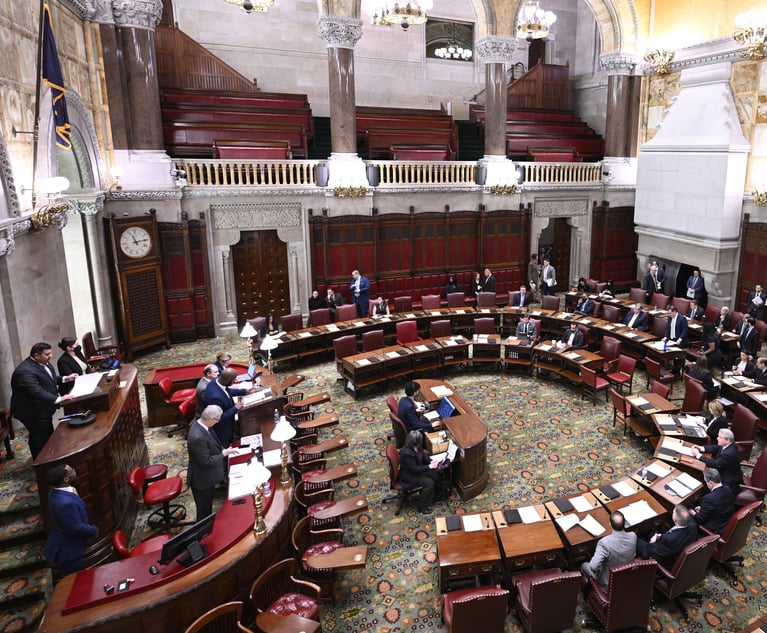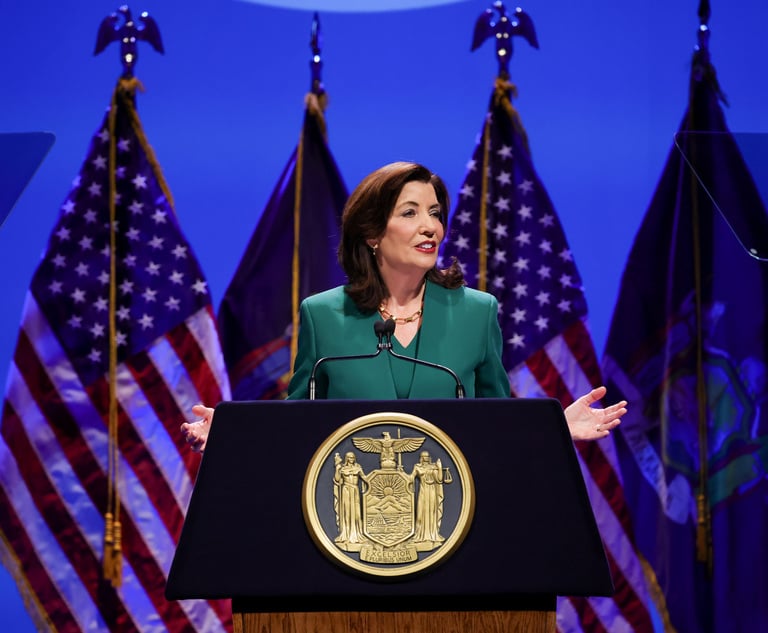NYC's Sexual Harassment Training Mandates Are Now in Effect
If employers have not already begun preparing for the annual training requirements, now is the time.
April 01, 2019 at 11:09 AM
9 minute read

Beginning April 1, 2019, employers with 15 or more employees in New York City must provide annual, interactive sexual harassment prevention training to their employees. This training requirement, one of a slew of mandates contained in the City's Stop Sexual Harassment Act, is in addition to the anti-sexual harassment training required by New York State, which became effective Oct. 9, 2018. However, one annual training session can satisfy both requirements.
Here's what employers need to know about the City's mandated training, how it compares with the State's requirements, and how employers can most effectively and efficiently meet their compliance obligations under both laws:
NYC's Sexual Harassment Training Mandates: Five Steps to Compliance
#1: Determine if you are a “covered” employer. As noted, the City's training requirement applies only to employers with 15 or more employees, but for employers with a workforce near that number, determining if the 15-employee threshold is met may be a little tricky. Guidance provided by the New York City Commission on Human Rights (“Commission”) (in the form of FAQs) instructs employers to answer the employee threshold question by determining the number of employees they employed “at any given point within the prior calendar year.” In making this assessment, employers must not only include all full-time and part-time workers and interns, but must also count independent contractors as “employees,” regardless of how many hours or days they worked in the prior year.
NYC-based employers that do not meet this threshold can stop right here, keeping in mind, however, that they still must comply with the State's training obligation, as that mandate applies to all private employers in New York State.
#2: Identify which workers must be trained. City employers must provide training to all employees employed within the City, including supervisory and managerial employees and interns, as well as independent contractors, who (i) work more than 80 hours in a calendar year and (ii) work for at least 90 days, either on a full-time or part-time basis. Those who do not meet the 90 days/80 hours threshold do not need to be trained.
If an employee or an independent contractor has received training elsewhere during the calendar year, they do not need to be retrained. However, it is the employer's responsibility to maintain records to demonstrate that each worker has been trained.
Further, the City's FAQs state that if New York City-based employers have employees who work outside of the City, but either (a) work a portion of their time in the City, or (b) interact with employees in New York City, they also must be trained.
In contrast, New York State's training mandate: (i) contains no specific thresholds (rather, the State's FAQs vaguely advises that employees who work a “portion of their time” in New York must be trained); (ii) does not include independent contractors; and (iii) does not provide for a waiting period for new hires. The State further explicitly requires training for minors.
#3: Determine when employees must be trained. The City's Guidance directs that covered workers be trained “as soon as possible,” unless the employee or independent contractor has received the mandated training at another employer within the required training cycle. Employees who have received the mandated training at any point in 2019 need not be trained again until the next annual training cycle. This means that employees who received compliant training in 2019 but prior to the City's April 1st effective date, need not be trained again until 2020.
New York State concurs on the “as soon as possible” standard for training, and requires that all employees complete the State's model training or a comparable, compliant training program by Oct. 9, 2019. The State Guidance warns that if employees have already received training this year, but that training did not meet all of the State's mandates, employers must provide supplemental training to ensure that all requirements are met. While the City's Guidance is silent on this point, logically, the same rule should apply.
Both the City and the State require annual training, and allow employers to decide whether, in subsequent years, the date of the training is based on the calendar year, the anniversary of each employee's start date, or any other date the employer chooses.
The bottom line on timing is thus: For 2019, the State training must be completed by October 9, 2019, and the City training by the end of the year. Starting in 2020, employers can determine the timing of their training, as long as every employee receives training on an annual basis.
#4: Choose or create a compliant training program that meets business and employee needs. The City's training program is available on its website. This training program, lasting approximately 45 minutes, is an online platform, which may be used on a computer or mobile device; however, the City online training program will not save progress if paused. The City training is accessible for users with disabilities and will be available in multiple languages (Spanish, French, Chinese, Korean, Haitian Creole, Bengali, Russian, Polish, Urdu, Arabic). The State has also created an online training program, which is available on its website, and is currently is available in Spanish, Bengali, Chinese, Korean, Russian, Italian, Polish and Haitian-Creole.
Guidance from both the City and State asserts that the relevant agencies of each jurisdiction are partnering with one another so that City-based employers can ensure compliance with the training mandates of both jurisdictions by using the City's training program. However, employers would be well advised to: (i) verify this assertion; and (ii) view the City's training program prior to adopting it. Assess both its content and form to determine its suitability and efficacy for the organization and its employees.
Alternatively, employers may develop or purchase a sexual harassment prevention training program that satisfies both City and State law, and is more customized to and appropriate for the needs of their business and employees. Such a program will likely be more effective, and, thus, perhaps more cost-efficient in the long run.
General Requirements
- Both the City and State mandate that the annual sexual harassment prevention training be interactive. This means that whether the training is conducted online or in-person, it must require some participation from the employee being trained, such as identifying appropriate responses to hypothetical situations or answering questions on various aspects of the law. Neither the City nor the State certifies trainers, nor does either have any certification requirements for trainers.
- Neither the City nor the State requires a specific number of training hours per year; rather, the training just has to meet or exceed the minimum content standards and be interactive.
- Both the City and State FAQs instruct that employers should provide training in the language spoken by their employees, or in a language that is accessible to them. The City and State training programs are available in a variety of languages.
- Employers must pay employees for the time spent in training, including new hires who have not yet officially assumed their positions.
Content Requirements
The City and State training requirements are similar in most respects:
- Define sex harassment and provide specific examples
- Explain federal & State harassment laws, e.g., Title VII of the Civil Rights Act of 1964 and NYSHRL (for NYC, add NYCHRL), and explain that sexual harassment is a form of unlawful discrimination
- Describe internal and external remedies & rights of redress available to employees, including the employer's complaint process
- Explain venues for adjudicating complaints, i.e., EEOC & NYSDHR (for NYC, add NYCCHR complaint process) and applicable contact information
- Educate on bystander intervention (recommended, but not required, by NYS)
- Explain responsibilities of supervisors and managers with respect to preventing/stopping harassment, handling complaints and avoiding retaliation
- Define retaliation and provide examples
#5: Establish a recordkeeping system. City law and Guidance require employers to maintain a record of all trainings, including a signed employee acknowledgement, for three years. These records may be kept electronically. State law does not mandate such recordkeeping, but the State's Guidance recommends that employers obtain employee acknowledgements and maintain training records.
One more point: for multi-state employers. The City law provides that an employer that is subject to training requirements in multiple jurisdictions, and therefore already has a training program, may use that program for its City employees, if it can “provide proof” that the training program is compliant with the City's requirements. At a minimum, however, such an employer would have to create or purchase a supplement for that program that, among other things, explained New York State and City law and described local venues for filing and adjudicating claims.
While only five states and one city now have anti-sexual harassment training requirements for private employers, more states and cities are likely to join them in the coming years. Indeed, a number of state legislatures are currently considering such measures. Accordingly, multi-state employers that wish to pursue this alternative, may want to create or purchase a generic training program designed to be supplemented by state-specific addenda.
Conclusion
If employers have not already begun preparing for the annual training requirements, now is the time. Employers should review the five steps for compliance to establish a training program that is effective for their workforce.
Susan Gross Sholinsky is a member and Nancy Gunzenhauser Popper is an associate in Epstein Becker Green's employment, labor and workforce management practice.
This content has been archived. It is available through our partners, LexisNexis® and Bloomberg Law.
To view this content, please continue to their sites.
Not a Lexis Subscriber?
Subscribe Now
Not a Bloomberg Law Subscriber?
Subscribe Now
NOT FOR REPRINT
© 2025 ALM Global, LLC, All Rights Reserved. Request academic re-use from www.copyright.com. All other uses, submit a request to [email protected]. For more information visit Asset & Logo Licensing.
You Might Like
View All

Federal Judge Pauses Trump Funding Freeze as Democratic AGs Plan Suit
4 minute read
Relaxing Penalties on Discovery Noncompliance Allows Criminal Cases to Get Decided on Merit
5 minute read
Bipartisan Lawmakers to Hochul Urge Greater Student Loan Forgiveness for Public-Interest Lawyers
Trending Stories
- 1Big Law's Middle East Bet: Will It Pay Off?
- 2'Translate Across Disciplines': Paul Hastings’ New Tech Transactions Leader
- 3Milbank’s Revenue and Profits Surge Following Demand Increases Across the Board
- 4Fourth Quarter Growth in Demand and Worked Rates Coincided with Countercyclical Dip, New Report Indicates
- 5Public Notices/Calendars
Who Got The Work
J. Brugh Lower of Gibbons has entered an appearance for industrial equipment supplier Devco Corporation in a pending trademark infringement lawsuit. The suit, accusing the defendant of selling knock-off Graco products, was filed Dec. 18 in New Jersey District Court by Rivkin Radler on behalf of Graco Inc. and Graco Minnesota. The case, assigned to U.S. District Judge Zahid N. Quraishi, is 3:24-cv-11294, Graco Inc. et al v. Devco Corporation.
Who Got The Work
Rebecca Maller-Stein and Kent A. Yalowitz of Arnold & Porter Kaye Scholer have entered their appearances for Hanaco Venture Capital and its executives, Lior Prosor and David Frankel, in a pending securities lawsuit. The action, filed on Dec. 24 in New York Southern District Court by Zell, Aron & Co. on behalf of Goldeneye Advisors, accuses the defendants of negligently and fraudulently managing the plaintiff's $1 million investment. The case, assigned to U.S. District Judge Vernon S. Broderick, is 1:24-cv-09918, Goldeneye Advisors, LLC v. Hanaco Venture Capital, Ltd. et al.
Who Got The Work
Attorneys from A&O Shearman has stepped in as defense counsel for Toronto-Dominion Bank and other defendants in a pending securities class action. The suit, filed Dec. 11 in New York Southern District Court by Bleichmar Fonti & Auld, accuses the defendants of concealing the bank's 'pervasive' deficiencies in regards to its compliance with the Bank Secrecy Act and the quality of its anti-money laundering controls. The case, assigned to U.S. District Judge Arun Subramanian, is 1:24-cv-09445, Gonzalez v. The Toronto-Dominion Bank et al.
Who Got The Work
Crown Castle International, a Pennsylvania company providing shared communications infrastructure, has turned to Luke D. Wolf of Gordon Rees Scully Mansukhani to fend off a pending breach-of-contract lawsuit. The court action, filed Nov. 25 in Michigan Eastern District Court by Hooper Hathaway PC on behalf of The Town Residences LLC, accuses Crown Castle of failing to transfer approximately $30,000 in utility payments from T-Mobile in breach of a roof-top lease and assignment agreement. The case, assigned to U.S. District Judge Susan K. Declercq, is 2:24-cv-13131, The Town Residences LLC v. T-Mobile US, Inc. et al.
Who Got The Work
Wilfred P. Coronato and Daniel M. Schwartz of McCarter & English have stepped in as defense counsel to Electrolux Home Products Inc. in a pending product liability lawsuit. The court action, filed Nov. 26 in New York Eastern District Court by Poulos Lopiccolo PC and Nagel Rice LLP on behalf of David Stern, alleges that the defendant's refrigerators’ drawers and shelving repeatedly break and fall apart within months after purchase. The case, assigned to U.S. District Judge Joan M. Azrack, is 2:24-cv-08204, Stern v. Electrolux Home Products, Inc.
Featured Firms
Law Offices of Gary Martin Hays & Associates, P.C.
(470) 294-1674
Law Offices of Mark E. Salomone
(857) 444-6468
Smith & Hassler
(713) 739-1250






